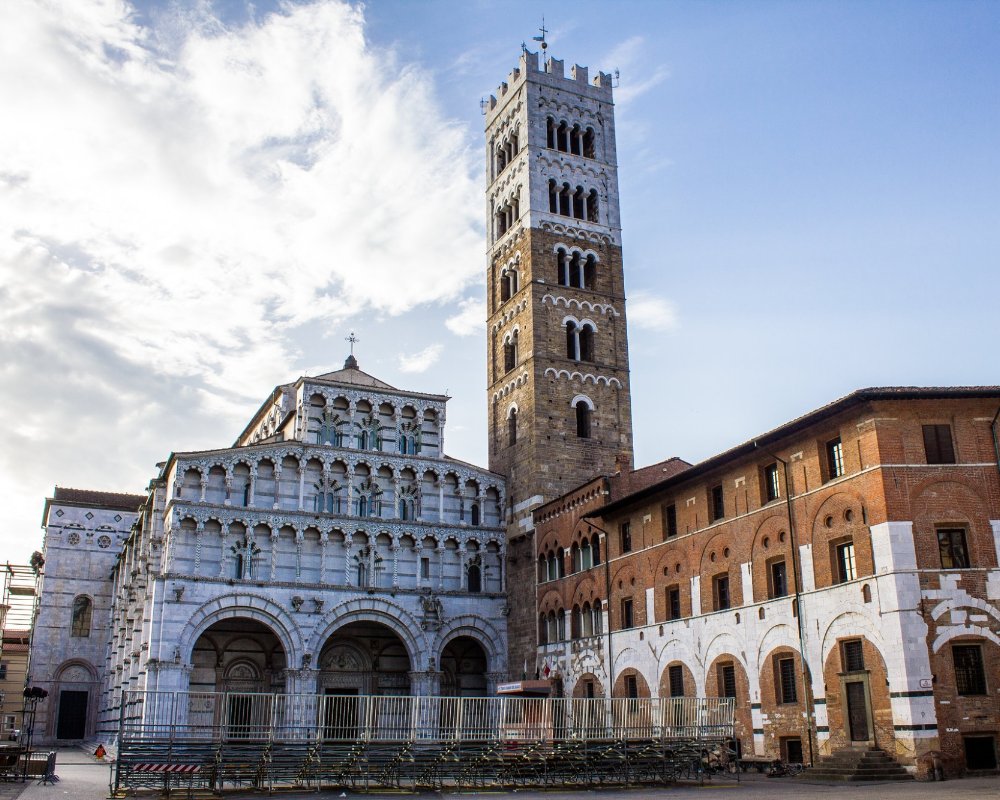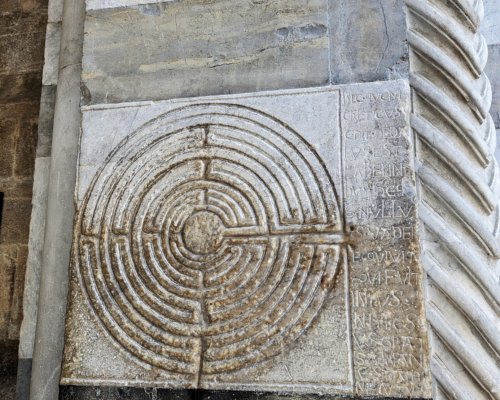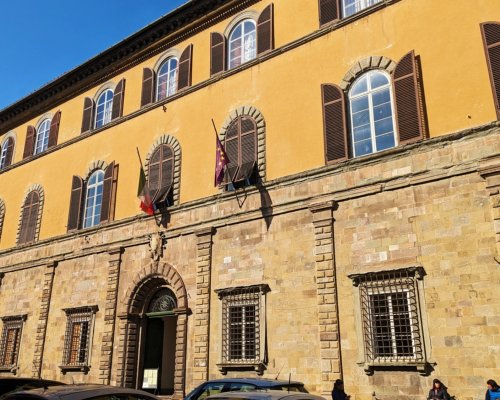Within the ancient walls of the city of art, history mixes with legend
A medieval city par excellence, Lucca is surrounded by an imposing city wall and, among the large towns in Tuscany, is among the ones that have kept more than any others their ancient layout intact. But in addition to the churches, splendid palaces and towers, there are also numerous stories, mysteries and curiosities that have been handed down through the centuries.
Ghosts, unexplained symbols and strange apparitions: let's discover this unusual Lucca together, hunting for its secrets in the historic town center.
Walking around Lucca, the Cathedral of San Martino will certainly amaze us, consecrated in 1070 and located in the square of the same name.
What intrigues us, at first glance, is the unusual asymmetry of the facade, which contrasts with the architectural harmony so sought after in the churches of old. But what catches the eye as we approach the Cathedral is the labyrinth carved in stone, accompanied by a Latin inscription referring to the myth of Theseus and the Minotaur.
But why carve a symbol that refers to paganism on the portico of a Christian building? This is not unique: the labyrinth has been depicted other times inside European churches, such as on the floor of the Cathedral of Chartres in France. The labyrinth is thought to be a metaphor for the path of Christianity, according to which the only way for man to arrive at salvation is to follow faith just as Theseus followed Ariadne's thread to get out of the darkness of the labyrinth. However, even after many centuries, its real meaning remains a mystery.
Walking around Lucca, the Cathedral of San Martino will certainly amaze us, consecrated in 1070 and located in the square of the same name.
What intrigues us, at first glance, is the unusual asymmetry of the facade, which contrasts with the architectural harmony so sought after in the churches of old. But what catches the eye as we approach the Cathedral is the labyrinth carved in stone, accompanied by a Latin inscription referring to the myth of Theseus and the Minotaur.
But why carve a symbol that refers to paganism on the portico of a Christian building? This is not unique: the labyrinth has been depicted other times inside European churches, such as on the floor of the Cathedral of Chartres in France. The labyrinth is thought to be a metaphor for the path of Christianity, according to which the only way for man to arrive at salvation is to follow faith just as Theseus followed Ariadne's thread to get out of the darkness of the labyrinth. However, even after many centuries, its real meaning remains a mystery.
Caught up in the rush to reach Lucca's main attractions, it is easy to miss Piazza Bernardini and its palace, a Renaissance building that belonged to an important merchant family. Yet this is where the protagonist of the next story hides, to the right of the doorway: it is the Devil's Stone, a window jamb that has an unnatural curvature.
It is said that the Devil had convinced the Bernardines to destroy, in order to make room for the building, a miraculous image of Our Lady much venerated by the citizens. As soon as the window was made, in the exact spot where the Madonna was placed, the stone became deformed and any attempt to straighten it was to no avail. Even when it was replaced, it immediately curved again. Eventually, it was decided to leave it as it was, and as we get closer to admire the facade of the building, we can still see it protruding.
But this is not the only mystery handed down by the people of Lucca that urges us not to deal with the devil: continuing and turning into Via Fillungo, the clock tower has another story to tell us.
Caught up in the rush to reach Lucca's main attractions, it is easy to miss Piazza Bernardini and its palace, a Renaissance building that belonged to an important merchant family. Yet this is where the protagonist of the next story hides, to the right of the doorway: it is the Devil's Stone, a window jamb that has an unnatural curvature.
It is said that the Devil had convinced the Bernardines to destroy, in order to make room for the building, a miraculous image of Our Lady much venerated by the citizens. As soon as the window was made, in the exact spot where the Madonna was placed, the stone became deformed and any attempt to straighten it was to no avail. Even when it was replaced, it immediately curved again. Eventually, it was decided to leave it as it was, and as we get closer to admire the facade of the building, we can still see it protruding.
But this is not the only mystery handed down by the people of Lucca that urges us not to deal with the devil: continuing and turning into Via Fillungo, the clock tower has another story to tell us.
The story of Lucida Mansi, a Lucca noblewoman who lived in the 17th century, is intertwined with legend, and it is difficult to tell where one ends and the other begins. Much is said about Lucida, who was apparently very attractive and engaged in numerous amorous adventures. One day, however, she spotted in the mirror a wrinkle on her own face: the passage of time was causing her beauty to fade. Vanity led her to make a pact with the Devil, who granted her 30 years of youth. After this time had passed, he would return to her to demand the agreed payment: her soul.
Exactly 30 years later, Lucida tried to trick the Devil and climbed the Torre delle Ore (Tower of Hours) before midnight to stop the bell, which would strike the hour of her death. She did not make it on time, however, and Lucifer took her away with him, loading her into his chariot and throwing himself into the waters of the pond of the Botanical Garden to return to hell.
Even today, it is said that her ghost roams near the body of water and her cries can be heard on full moon nights.
The story of Lucida Mansi, a Lucca noblewoman who lived in the 17th century, is intertwined with legend, and it is difficult to tell where one ends and the other begins. Much is said about Lucida, who was apparently very attractive and engaged in numerous amorous adventures. One day, however, she spotted in the mirror a wrinkle on her own face: the passage of time was causing her beauty to fade. Vanity led her to make a pact with the Devil, who granted her 30 years of youth. After this time had passed, he would return to her to demand the agreed payment: her soul.
Exactly 30 years later, Lucida tried to trick the Devil and climbed the Torre delle Ore (Tower of Hours) before midnight to stop the bell, which would strike the hour of her death. She did not make it on time, however, and Lucifer took her away with him, loading her into his chariot and throwing himself into the waters of the pond of the Botanical Garden to return to hell.
Even today, it is said that her ghost roams near the body of water and her cries can be heard on full moon nights.
Piazza San Michele is located on the site where the ancient Roman forum once stood, which is why the church built here is called San Michele in Foro (St. Michael in the Forum). On its summit towers, as if guarding the city from above, the marble statue dedicated to the Archangel: a beautifully crafted work of metal wings and depicting the victorious saint as he pierces the dragon with a spear.
The sculpture is said to wear a very precious emerald that has remained embedded in a ring since ancient times, and only a very keen eye, on particularly bright days, is able to discern the sparkle of the jewel. So many have attempted to observe the emerald's green reflection: some have succeeded, while others have not been so lucky. However, this has only added to the aura of mystery around this tale, which continues to lead many visitors here who hope to catch a glimpse of it.
Piazza San Michele is located on the site where the ancient Roman forum once stood, which is why the church built here is called San Michele in Foro (St. Michael in the Forum). On its summit towers, as if guarding the city from above, the marble statue dedicated to the Archangel: a beautifully crafted work of metal wings and depicting the victorious saint as he pierces the dragon with a spear.
The sculpture is said to wear a very precious emerald that has remained embedded in a ring since ancient times, and only a very keen eye, on particularly bright days, is able to discern the sparkle of the jewel. So many have attempted to observe the emerald's green reflection: some have succeeded, while others have not been so lucky. However, this has only added to the aura of mystery around this tale, which continues to lead many visitors here who hope to catch a glimpse of it.
On the left side of the Basilica of San Frediano (looking at the facade), we find a secondary door called "of the Angel." Tradition has it that it witnessed a prodigious event involving Saint Zita, who lived in the 13th century and at the time was a maid in Lucca of the wealthy Fatinelli family.
According to the stories, one day Zita met a poor man who was suffering and cold. Moved with compassion, she returned to the palace where she was serving, took a cloak and brought it to the man. The master never noticed: the next day, the woman found an angel waiting for her on the threshold of the basilica's side door, who returned a new cloak to her.
Great devotion grew around Saint Zita even while she was still alive, and her fame led to her being mentioned even by Dante Alighieri in the Divine Comedy. Her remains are still visible today in the Basilica of San Frediano, in a transparent shrine in the chapel dedicated to her.
On the left side of the Basilica of San Frediano (looking at the facade), we find a secondary door called "of the Angel." Tradition has it that it witnessed a prodigious event involving Saint Zita, who lived in the 13th century and at the time was a maid in Lucca of the wealthy Fatinelli family.
According to the stories, one day Zita met a poor man who was suffering and cold. Moved with compassion, she returned to the palace where she was serving, took a cloak and brought it to the man. The master never noticed: the next day, the woman found an angel waiting for her on the threshold of the basilica's side door, who returned a new cloak to her.
Great devotion grew around Saint Zita even while she was still alive, and her fame led to her being mentioned even by Dante Alighieri in the Divine Comedy. Her remains are still visible today in the Basilica of San Frediano, in a transparent shrine in the chapel dedicated to her.


